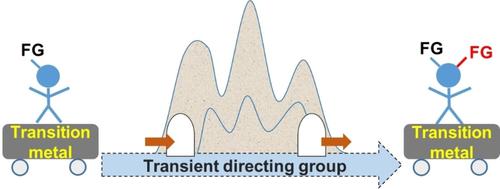当前位置:
X-MOL 学术
›
ChemistrySelect
›
论文详情
Our official English website, www.x-mol.net, welcomes your feedback! (Note: you will need to create a separate account there.)
Advances in Development of C–H Activation/Functionalization Using a Catalytic Directing Group
ChemistrySelect ( IF 2.1 ) Pub Date : 2018-06-01 , DOI: 10.1002/slct.201801097 Omer K. Rasheed 1, 2 , Bing Sun 1
ChemistrySelect ( IF 2.1 ) Pub Date : 2018-06-01 , DOI: 10.1002/slct.201801097 Omer K. Rasheed 1, 2 , Bing Sun 1
Affiliation

|
The transition metal catalyzed direct site‐selective carbon –hydrogen functionalization is ubiquitous in organic synthesis and has reached an impressive level of sophistication and efficiency emerging as a powerful synthetic strategy for C–C bond and C–X bond formation to access various useful arylated organic molecules. For the past two decades, directing group strategy has been used for selective activation and functionalization of certain inert C–H bonds. Despite the enormous development in this field, still, the majority of systems require two redundant steps, i. e. installation and removal of DGs. To overcome these limitations, recently, traceless and multitasking groups were invented as a partial solution to DG release however installation still remains unsolved. Ideally, use of the catalytic directing group, which can be reversibly linked to the substrate and can serve as an efficient directing role would circumvent this problem and is considered as one of the most efficient and powerful strategies for the non‐activated C–H functionalization (C(sp2)–H or C(sp3)–H). In this review, we describe the enormous advances in this field for direct selective C–H functionalization without involving additional steps, i. e. installation and removal of directing groups and also discuss less explored but significant non‐covalent interactions such as hydrogen bonding or ion pairing, which helps to control the selectivity of a substrate in a catalytic organic reaction.
中文翻译:

使用催化导向基团开发C–H活化/功能化的进展
过渡金属催化的直接位选择性碳氢官能团在有机合成中无处不在,并且已经达到令人印象深刻的复杂程度和效率,这已成为构成C–C键和C–X键形成以访问各种有用的芳基化有机物的有力合成策略分子。在过去的二十年中,使用定向基团策略对某些惰性C–H键进行选择性活化和功能化。尽管在这一领域已取得了巨大的发展,但是大多数系统仍需要两个冗余步骤,即:e。DG的安装和拆卸。为了克服这些限制,最近,无痕和多任务组被发明为DG发布的部分解决方案,但是安装仍未解决。理想情况下,使用催化导向基团2)–H或C(sp 3)–H)。在这篇综述中,我们描述了在不涉及其他步骤的情况下,直接选择性C–H功能化在该领域的巨大进步。e。指导基团的安装和去除,还讨论了较少探索但重要的非共价相互作用,例如氢键或离子对,这有助于控制催化有机反应中底物的选择性。
更新日期:2018-06-01
中文翻译:

使用催化导向基团开发C–H活化/功能化的进展
过渡金属催化的直接位选择性碳氢官能团在有机合成中无处不在,并且已经达到令人印象深刻的复杂程度和效率,这已成为构成C–C键和C–X键形成以访问各种有用的芳基化有机物的有力合成策略分子。在过去的二十年中,使用定向基团策略对某些惰性C–H键进行选择性活化和功能化。尽管在这一领域已取得了巨大的发展,但是大多数系统仍需要两个冗余步骤,即:e。DG的安装和拆卸。为了克服这些限制,最近,无痕和多任务组被发明为DG发布的部分解决方案,但是安装仍未解决。理想情况下,使用催化导向基团2)–H或C(sp 3)–H)。在这篇综述中,我们描述了在不涉及其他步骤的情况下,直接选择性C–H功能化在该领域的巨大进步。e。指导基团的安装和去除,还讨论了较少探索但重要的非共价相互作用,例如氢键或离子对,这有助于控制催化有机反应中底物的选择性。



























 京公网安备 11010802027423号
京公网安备 11010802027423号